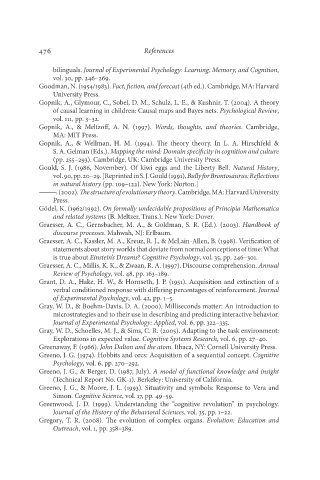Page 493 - Deep Learning
P. 493
476 References
bilinguals. Journal of Experimental Psychology: Learning, Memory, and Cognition,
vol. 30, pp. 246–269.
Goodman, N. (1954/1983). Fact, fiction, and forecast (4th ed.). Cambridge, MA: Harvard
University Press.
Gopnik, A., Glymour, C., Sobel, D. M., Schulz, L. E., & Kushnir, T. (2004). A theory
of causal learning in children: Causal maps and Bayes nets. Psychological Review,
vol. 111, pp. 3–32.
Gopnik, A., & Meltzoff, A. N. (1997). Words, thoughts, and theories. Cambridge,
MA: MIT Press.
Gopnik, A., & Wellman, H. M. (1994). The theory theory. In L. A. Hirschfeld &
S. A. Gelman (Eds.), Mapping the mind: Domain specificity in cognition and culture
(pp. 255–293). Cambridge, UK: Cambridge University Press.
Gould, S. J. (1986, November). Of kiwi eggs and the Liberty Bell. Natural History,
vol. 90, pp. 20–29. [Reprinted in S. J. Gould (1991), Bully for Brontosaurus: Reflections
in natural history (pp. 109–122). New York: Norton.]
———. (2002). The structure of evolutionary theory. Cambridge, MA: Harvard University
Press.
Gödel, K. (1962/1992). On formally undecidable propositions of Principia Mathematica
and related systems (B. Meltzer, Trans.). New York: Dover.
Graesser, A. C., Gernsbacher, M. A., & Goldman, S. R. (Ed.). (2003). Handbook of
discourse processes. Mahwah, NJ: Erlbaum.
Graesser, A. C., Kassler, M. A., Kreuz, R. J., & McLain-Allen, B. (1998). Verification of
statements about story worlds that deviate from normal conceptions of time: What
is true about Einstein’s Dreams? Cognitive Psychology, vol. 35, pp. 246–301.
Graesser, A. C., Millis, K. K., & Zwaan, R. A. (1997). Discourse comprehension. Annual
Review of Psychology, vol. 48, pp. 163–189.
Grant, D. A., Hake, H. W., & Hornseth, J. P. (1951). Acquisition and extinction of a
verbal conditioned response with differing percentages of reinforcement. Journal
of Experimental Psychology, vol. 42, pp. 1–5.
Gray, W. D., & Boehm-Davis, D. A. (2000). Milliseconds matter: An introduction to
microstrategies and to their use in describing and predicting interactive behavior.
Journal of Experimental Psychology: Applied, vol. 6, pp. 322–335.
Gray, W. D., Schoelles, M. J., & Sims, C. R. (2005). Adapting to the task environment:
Explorations in expected value. Cognitive Systems Research, vol. 6, pp. 27–40.
Greenaway, F. (1966). John Dalton and the atom. Ithaca, NY: Cornell University Press.
Greeno, J. G. (1974). Hobbits and orcs: Acquisition of a sequential concept. Cognitive
Psychology, vol. 6, pp. 270–292.
Greeno, J. G., & Berger, D. (1987, July). A model of functional knowledge and insight
(Technical Report No. GK-1). Berkeley: University of California.
Greeno, J. G., & Moore, J. L. (1993). Situativity and symbols: Response to Vera and
Simon. Cognitive Science, vol. 17, pp. 49–59.
Greenwood, J. D. (1999). Understanding the “cognitive revolution” in psychology.
Journal of the History of the Behavioral Sciences, vol. 35, pp. 1–22.
Gregory, T. R. (2008). The evolution of complex organs. Evolution: Education and
Outreach, vol. 1, pp. 358–389.

